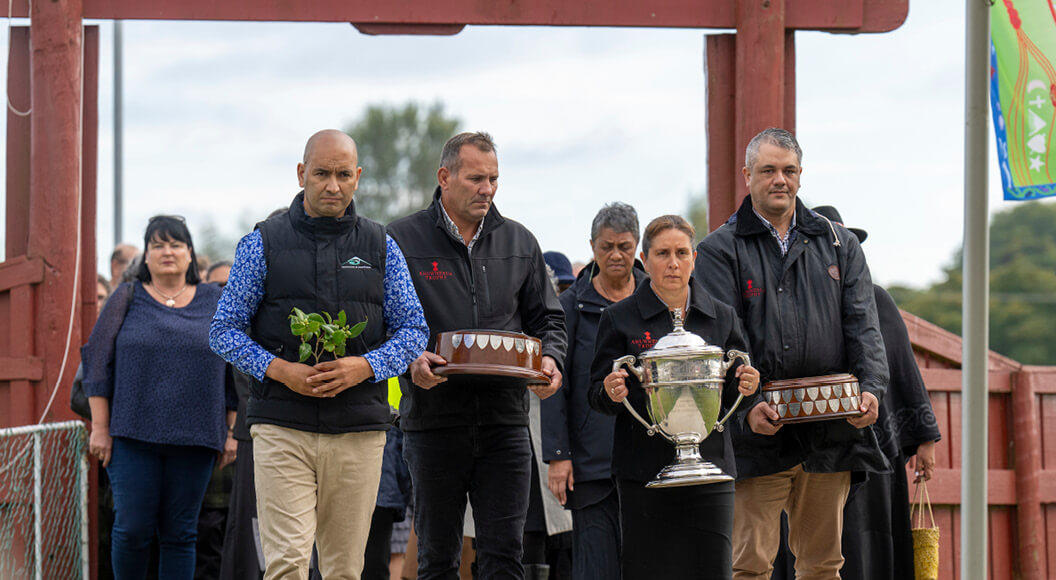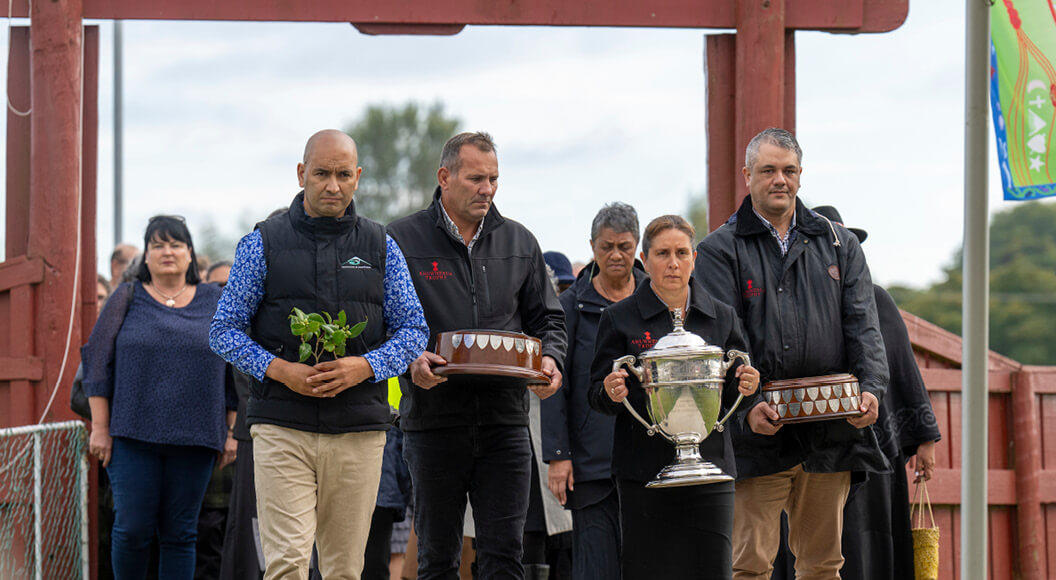
Ahuwhenua Trophy Field Day - Whakatōhea Māori Trust Board
Around 250 people attended this week’s field day at Whakatōhea Māori Trust Board’s dairy farm in the Eastern Bay of Plenty.
Whakatōhea is a finalist in this year’s Ahuwhenua Trophy competition to select the top Māori dairy farm in Aotearoa. As part of the competition each finalist stages a field day at their farm, giving judges and members of the public the chance to come and see the property and hear more about how it has made it through to the finals of this prestigious competition.
Whakatōhea Māori Trust Board’s dairy farm, Te Riu o Kānapanapa, is a collective of five dairy farms and is located 4km south of Ōpōtiki. The dairy platform is 218ha effective made up of 175.7ha of corpus whenua, plus an additional 29ha and a 13.3ha lease block. The farm winters 748 cows and milks 690 to peak with a production target of 300,000 kg/MS. They also rear stock on a 346ha support block at the Motu, 10km north of Matawai in the Gisborne catchment. There are four permanent staff on-farm and one casual, along with two calf rearers when required.
After being welcomed on at Terere Marae, guests heard presentations from trustees and Whakatōhea staff and were later taken out to the dairy farm to see stock and hear further information about their farm systems.
Among the guests on the day was the Minister for Māori Development, Hon Tama Potaka. He described the field day as outstanding, saying it was a day to celebrate Māori farming and Māori business, as well as New Zealand’s primary sector. “This is something that Māori are massive contributors to and will continue to be in a growing and expanding form over time,” he says.
The CEO of Whakatōhea, Dickie Farrar says the field day was fantastic with people coming from afar to learn about the farm and the history of Whakatōhea. She says she found it inspirational seeing all the hard work of her staff coming together, as well as to understand the tremendous effort that goes into the running of the competition, including the judging process.
Dickie Farrar says Whakatōhea learned a lot from the competition process, including by attending the field day of the other finalist, Wairarapa Moana ki Pouakani Incorporation.
The Chair the Ahuwhenua Trophy Management Committee, Nukuhia Hadfield says Whakatōhea turned on a great field day and people were impressed with what they saw. She says field days such as this are an excellent way of sharing our stories and showcasing the achievements of Māori.
She says Whakatōhea, like many farms in the region, had a difficult year with adverse weather conditions which made for challenging times for staff trying to manage the property. “But it was great to see just how proud Whakatōhea are of their dairy farming operation and what they have been able to achieve,” she says.
“Whakatōhea have a proud history and an impressive vision which is strongly entrepreneurial, weaving together six strategic pou: cultural identity, language and heritage, being well educated, healthy, socially connected, economically and commercially savvy,” she says.
Nukuhia Hadfield says the two finalists in the competition, Whakatōhea Māori Trust Board and Wairarapa Moana ki Pouakani Incorporation would both be worthy winners and says she is looking forward to the announcement of the winner at the awards dinner being held in Hamilton on 17th May 2024.
Finalist Profile
Whakatōhea Māori Trust Board
Whakatōhea Māori Trust Board derives mana motuhake from Ranginui and Papatūānuku and the eight generations of whakapapa to Irakewa and Wekanui, the parents of our ancestress, Muriwai of the Mataatua waka. The union of Muriwai’s daughter, Hine-i-kauia to the warlord Tūtāmure of the Nukutere waka laid the foundation for the Whakatōhea iwi to reside within their boundaries from Ohiwa harbour to the west, Opape in the east and the Motu in the south.
In 1866 Whakatōhea lived along the rich alluvial shores of the Eastern Bay of Plenty, known as te rohe o Whakatōhea, later known as Ōpōtiki. It was during this time 144,000 acres of Whakatōhea land was confiscated, and Whakatōhea people were left to perish on the Opape Native Reserve. The remaining 491,000 acres was uninhabitable mountainous hinterland.
In 1914, a petition to Parliament enabled compensation of £20,000 to be paid to Whakatōhea to purchase J.G Murray dairy farm on 1 October 1952. Three years later, the Whakatōhea Māori Trust Board was formed under the Māori Trust Board Act 1955.
The Trust Board is governed by twelve members, nominated and elected by the hapū they represent: Ngai Tamahaua, Ngāti Ruatakenga, Ngāti Patumoana, Ngāti Ngāhere, Ngāti Ira and Te Upokorehe. Two members are required to represent each of the six hapū in a three year cycle. The Governance Board has a broad range of skills, ranging from two dairy farmers with a combined experience of 115 years, an associate professor of research, a doctor of education, legal expertise in HR, policy, health, and environment, and business expertise, with one trustee having a masters in technological futures.
Whakatōhea Māori Trust Board’s vision is for it to be the food bowl that feeds the world – “Ko Te Kai Hoki i Waiaua.” This is not just about food. The vision confirms our entrepreneurial spirit, weaving together our six strategic pou: cultural identity, language and heritage, being well educated, healthy, socially connected, economically and commercially savy. A key priority are our regenerative strategies which have strengthened our responsibilities as kaitiaki of the environment we exist in. These pou have been the catalyst for Whakatōhea Māori Trust Board’s 50 year strategy.
The Farm Committee is made up of three trustees, the Chief Executive, the farm consultant, farm manager and support block manager, the finance manager and an administrator. There are four permanent staff on-farm and one casual, along with two calf rearers when required. Our farm strategies have been developed from the team on the ground, inclusive of senior leadership, farm committee and governance members. We fully support staff training, and external visits to other farms, and field days for the committee and farm team.
Whakatōhea Māori Trust Board’s dairy farm named Te Riu o Kānapanapa is a collective of five dairy farms and is located 4km south of Ōpōtiki along the Waioweka straight. The dairy platform is 218ha effective made up of 175.7ha of corpus whenua, 29ha addition to the block and 13.3ha leased. The 3-4 farming system has helped balance on farm feed and external sourcing.
The land is flat and is made up of alluvial soil, with loam, sand, stones and acidic clay on some parts of the blocks. The Waioweka river runs the length of the dairy farm and has a stopbank in place to protect the land.
The farm winters 748 cows and milks 690 to peak. We rear stock at Whakapaupākihi, a 346ha support block at the Motu, 10km north of Matawai in the Gisborne catchment. This financial year we raised 190 R1 heifers, 190 dairy heifer calves and 350 beef calves.
Our approach has been to work in an integrated way across our organisations six pou to achieve a balance of social, cultural, environmental and financial return on investment.


